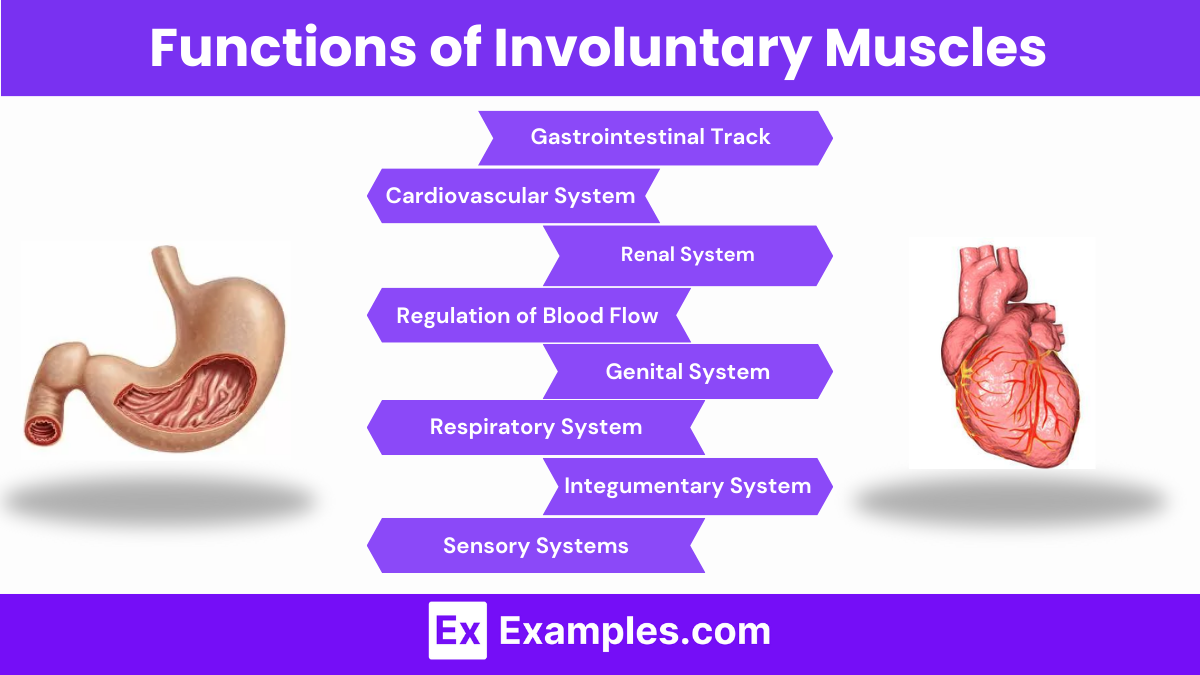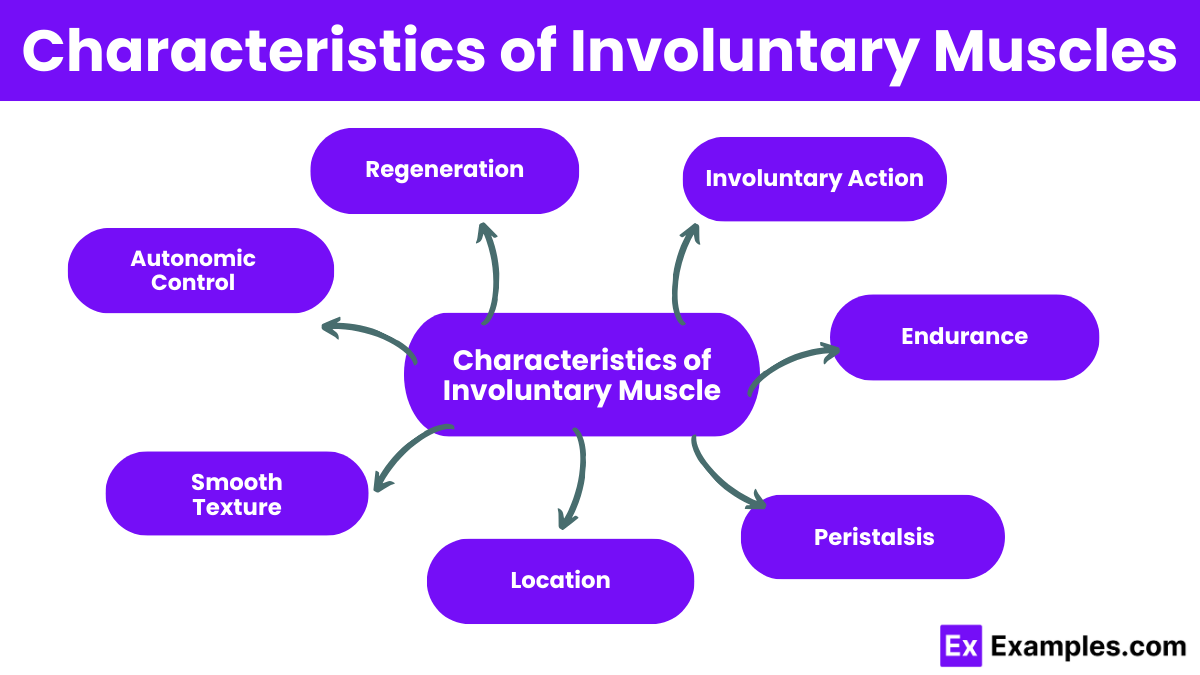Which of the following is an example of an involuntary muscle?
Biceps
Quadriceps
Heart
Triceps


Involuntary muscles operate without conscious control and are primarily governed by the autonomic nervous system. They include the smooth muscles found in the walls of internal organs like the stomach and intestines, and the cardiac muscle of the heart. Unlike voluntary muscles, which respond to conscious commands, involuntary muscles function continuously and automatically to manage essential bodily functions, such as heartbeats and digestion. These muscles typically exhibit slower, rhythmic contractions that maintain vital body processes without direct voluntary input.
An involuntary muscle is a type of muscle that contracts autonomously, without the need for conscious control. It comprises smooth and cardiac muscles, with smooth muscles lining the internal organs and blood vessels, and cardiac muscles forming the heart’s structure. The autonomic nervous system primarily regulates these muscles, facilitating vital functions across the body.
Involuntary muscles, primarily comprised of smooth and cardiac muscle types, play crucial roles in body functions without conscious control. Muscle smooth , found in various organ systems, and cardiac muscle, located in the heart, each have unique structural features and functions that enable them to perform essential physiological tasks efficiently.
Smooth muscle cells are spindle-shaped with a central bulge and tapered ends, known as fusiform. These cells lack the striations seen in skeletal muscle because their actin and myosin filaments do not form sarcomeres. Instead, these proteins interlace irregularly throughout the cell, anchored by structures called dense bodies. Dense bodies appear as dark spots under an electron microscope and serve as connection points for actin filaments, facilitating the muscle’s contraction and relaxation processes.
The contraction mechanism in smooth muscle involves a complex interaction between actin and myosin, driven by calcium ions from the sarcoplasmic reticulum. This process allows smooth muscle to maintain tension over extended periods, crucial for functions such as controlling blood flow or regulating internal pressures. Moreover, smooth muscle can stretch significantly, providing great elasticity, which is vital for organs like the urinary bladder that require continuous contractile tone.
Smooth muscle cells connect to each other via adherens junctions and gap junctions (connexins), enabling them to contract in unison in a coordinated manner often described as a spiral corkscrew motion. This synchronized activity is essential for propelling substances through hollow organ systems, such as food in the gastrointestinal tract or urine in the renal system.
Cardiac muscle, while also involuntary, is striated like skeletal muscle. This structuring allows cardiac muscle fibers to contract powerfully and rhythmically. Cardiac cells, or cardiomyocytes, connect at intercalated discs that facilitate rapid signal transmission and synchronization of heart contractions. This synchronization is critical for maintaining a steady heartbeat.
Cardiac muscle’s primary function is to pump blood throughout the body, supplying oxygen and nutrients while removing waste products. This muscle type’s ability to work continuously without fatigue is vital for survival.

Involuntary muscles contribute to a wide array of vital body functions across different organ systems:

Involuntary muscles, also known as smooth muscles, play essential roles in the human body by controlling various automatic functions. Here are key characteristics of these muscles
The movement of involuntary muscles is critical for various bodily functions, including digestion, blood flow, and respiratory processes. Here’s how these muscles operate:
As a biology professor, I find that understanding the role and functionality of involuntary muscles can significantly enhance students’ comprehension of human physiology. Involuntary muscles, or smooth muscles, perform essential functions that sustain life without requiring conscious thought. Here, I’ll describe some prime examples of involuntary muscles and their importance in various bodily functions.
In the cardiovascular system, smooth muscles in the walls of arteries and veins control blood pressure and flow. When these muscles contract, they narrow the vessels’ diameter—a process known as vasoconstriction. Conversely, when they relax, the vessels widen, which is vasodilation. These actions regulate blood circulation based on the body’s needs, such as increasing blood flow during exercise or conserving heat in cold environments.
The digestive tract heavily relies on smooth muscles. In the stomach and intestines, these muscles facilitate the movement of food. Through coordinated contractions known as peristalsis, smooth muscles push food through the digestive system, allowing for nutrient absorption and eventual waste excretion. This rhythmic contraction ensures that digestion occurs efficiently, regardless of the body’s position or activity level.
In the respiratory system, involuntary muscles around the bronchi control the airway’s width. These muscles relax or contract to adjust airflow to the lungs, responding to various conditions such as physical activity or exposure to irritants. For example, during an asthma attack, these muscles contract excessively, narrowing the airways and making breathing difficult.
The urinary bladder also contains smooth muscles, known as the detrusor muscles. These muscles contract to expel urine from the bladder during urination. Their coordinated action with sphincter muscles, which relax at the same time, allows for effective bladder control.
In females, the uterus is another critical organ composed of smooth muscle. During childbirth, these muscles contract rhythmically in what is commonly referred to as labor pains. This action helps to push the baby through the birth canal, illustrating a vital function of involuntary muscles in reproduction.
Muscles in the intestines, bladder, stomach, arteries, and respiratory tract are key examples of involuntary muscles.
Smooth muscles, cardiac muscles, and some eye muscles are involuntary.
Involuntary muscle movement occurs automatically without conscious control, essential for bodily functions like digestion and circulation.
The heart beating is a prime example of involuntary muscle control, functioning continuously without conscious effort.
Text prompt
Add Tone
10 Examples of Public speaking
20 Examples of Gas lighting
Which of the following is an example of an involuntary muscle?
Biceps
Quadriceps
Heart
Triceps
Involuntary muscles are primarily controlled by:
Somatic nervous system
Autonomic nervous system
Central nervous system
Peripheral nervous system
Which type of muscle is found in the walls of internal organs?
Skeletal muscle
Voluntary muscle
Cardiac muscle
Smooth muscle
Which of the following activities involves involuntary muscles?
Running
Blinking
Digesting food
Writing
The primary function of involuntary muscles in the digestive system is to:
Move bones
Pump blood
Facilitate peristalsis
Produce hormones
Cardiac muscle is unique because it:
Is voluntary
Is found in the stomach
Has both smooth and skeletal muscle characteristics
Contracts without neural stimulation
Which part of the brain regulates the function of involuntary muscles?
Cerebrum
Cerebellum
Medulla oblongata
Hippocampus
Smooth muscle contractions are typically:
Rapid and forceful
Slow and sustained
Random and irregular
Voluntary and precise
Involuntary muscles are essential for which bodily function?
Voluntary movement
Reflex actions
Vision
Breathing
Which of the following is NOT a characteristic of smooth muscle?
Striated appearance
Involuntary control
Located in walls of hollow organs
Slow to contract and relax
Before you leave, take our quick quiz to enhance your learning!

